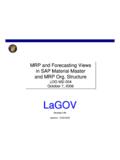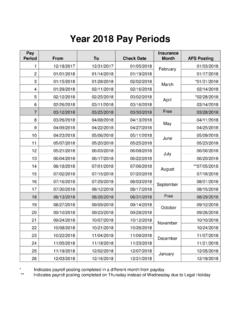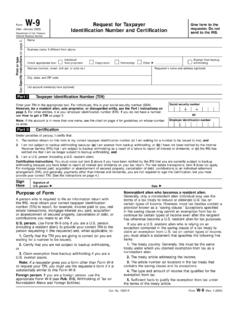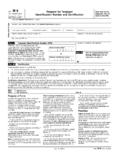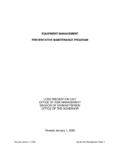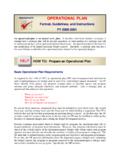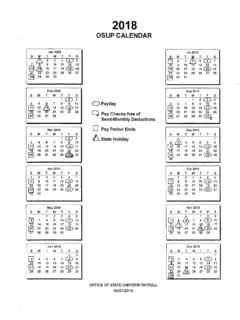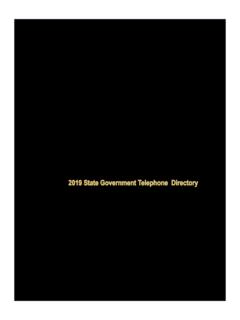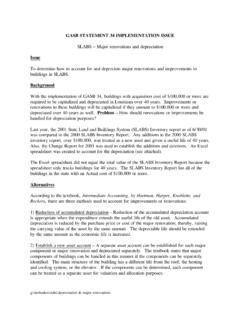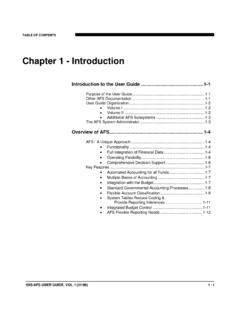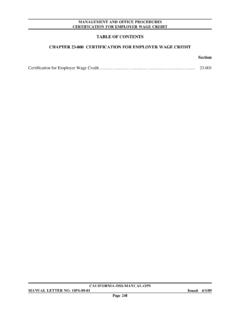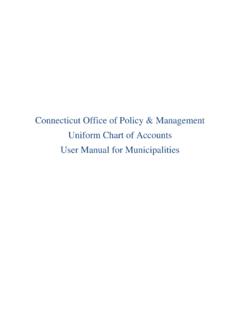Transcription of Chapter 3 - The AFS Chart of Accounts
1 TABLE OF CONTENTS ISIS/AFS USER GUIDE, VOL. I (01/98) 3 - i Chapter 3 - The AFS Chart of Accounts Overview .. 3-1 Flexible account code 3-1 Chart of Accounts - Issues & Concepts .. 3-2 Defining the Chart of Accounts .. 3-2 Coded and Inferred Attributes .. 3-3 AFS Reporting 3-5 Available Hierarchies .. 3-5 Agency 3-6 Using the Agency Hierarchy .. 3-6 Implementing the Agency 3-7 Organization Hierarchy .. 3-7 Organization Budget 3-9 Organizational Reporting Hierarchy .. 3-11 3-12 Louisiana Organization Hierarchy .. 3-12 Implementing Organization Hierarchies .. 3-13 Balance Sheet account Hierarchy .. 3-15 Implementing Balance Sheet account Hierarchies .. 3-15 Fund 3-16 Implementing Fund 3-16 Administrative 3-16 Object of Expenditure Hierarchy .. 3-17 Using the Object code Hierarchy.
2 3-18 3-18 Implementing Object Hierarchies .. 3-18 Revenue Source Hierarchy .. 3-19 Using the Revenue Source Hierarchy .. 3-19 Sub-Revenue Source .. 3-20 Implementing Revenue Source Hierarchies .. 3-20 Default Codes .. 3-20 Bank account code .. 3-20 Cash account code .. 3-22 Fund Type .. 3-22 Fund Group .. 3-23 Balance Sheet account Codes .. 3-23 Vouchers Payable .. 3-24 Cancel Vouchers Payable .. 3-24 TABLE OF CONTENTS 3 - ii ISIS/AFS USER GUIDE, VOL. 1 (01/98) Withholding 3-24 A/P 3-24 Warrant Clearing Fund .. 3-24 Warrant Payables account .. 3-25 Use Tax account .. 3-25 Liens Payable account .. 3-25 Reserve for Pre-Encumbrances .. 3-25 Reserve for Encumbrances .. 3-25 Reserve for Encumbrances Payroll .. 3-25 Fund Balance .. 3-25 Agency Due 3-25 Due To/Due From Other 3-25 Retained Earnings.
3 3-25 Warrants 3-25 Warrants Received .. 3-25 Automatic Transfers 3-26 Deposit Cash account .. 3-26 Deposit Suspense Fund .. 3-26 Deposit Suspense account .. 3-26 Lines of Credit .. 3-26 Accounts Receivable Accounts .. 3-26 Other 3-26 account Type 3-27 Proprietary Accounts .. 3-27 Temporary Accounts .. 3-28 Budgetary Accounts .. 3-28 Debits and Credits .. 3-28 AFS Chart OF Accounts ISIS/AFS USER GUIDE, VOL. I (01/98) 3 - 1 Chapter 3 - The AFS Chart of Accounts Overview The AFS codes defined in your installation's master tables are used to identify and classify all financial data (transactions) stored in AFS. For standard accounting transactions, codes defining an organization, agency, and either a revenue source or object of expenditure are required. Fund and appropriation codes are inferred from the organization code .
4 Balance sheet transactions require fund, agency and balance sheet account . Other optional codes, such as sub-object, and reporting category, may also be specified. The complete account code distribution used with a transaction is stored with the transaction code in a ledger file, where it is available for reporting purposes. All types of financial transactions (budgeting, accounting, and those for the optional subsystems such as cost allocation and inventory) are input to AFS with the same set of valid codes. It is this single set of codes that integrates the various functions of AFS into one system. It ensures that all AFS data is compatible, so that data gathered for one function can be used meaningfully for comparisons and computations by any of the other functions. Flexible account The AFS account code structure contributes to user flexibility; it enables managers code Structure to enforce detailed coding for some areas while allowing minimal coding for others.
5 Through various system options and internally-enforced office procedures, the account code structure can be used to achieve reporting in exactly the level of detail desired for various situations. The following items summarize the flexible aspects of the AFS account code structure: Budget vs. Accounting Level of Detail. Accounting transactions may be coded at a more detailed level than budgets by using sub-revenue, sub-object, reporting category, and job number codes. Every agency can develop its own budget, at the desired level of detail, and still use additional codes on accounting transactions for cost accounting and reporting. Organization Enforced Coding Options. Through options selected for each fund/agency combination, organization codes can be required on transactions. These organization code options are chosen on the basis of reporting requirements of individual agencies or tracking requirements for particular funds.
6 These options are controlled by the Appropriation Organization Option, Expense Budget Organization Option, and the Revenue Budget Organization Option coded on Fund Agency (FGY2). Other Enforced Coding Options. Some options are set on a system-wide basis. Through the Reporting Category option on Balance Sheet account (BAC2), a AFS Chart OF Accounts 3 - 2 ISIS/AFS USER GUIDE, VOL. 1 (01/98) reporting category can be required on transactions for selected balance sheet Accounts . The reporting category code can be made mandatory for some balance sheet Accounts and optional for others. Similarly, through the Sub-Revenue Source Option on Revenue Source (RSR2), a sub-revenue source code can be made mandatory for selected revenue sources and remain optional for others. Also, the Sub-Object Option on the Expense Budget (EB) transaction can require a sub-object code for specific budget lines in the Expense Budget Table.
7 Reporting Category Codes. The meaning and use of this code can be defined by each installation. It is a way to provide one more level of detail for cost accounting purposes. Reporting categories may be used to describe the contributors to balance sheet Accounts (to identify the debtors to a billed receivables account for example). An entirely different use would be to define reporting categories to mean specific locations (to identify parishes, for example, or to identify neighborhoods in a city). Hierarchies. The government as a whole decides whether to institute roll-up reporting hierarchies (the class and category codes) within the account coding structure. These hierarchies summarize and group transactions for reporting purposes. These hierarchies are described later in this Chapter .
8 All options mentioned above are described in detail in Chapter 4 of the User Guide, Vo l . I . Chart of Accounts - Issues & Concepts Defining the All AFS codes are defined in master tables. Before a code can be used on a trans- Chart of Accounts action or in a master table as a default, it must be defined in the appropriate master table. Fund codes, for example, must be listed in Fund (FUN2) for each fiscal year in which they are used. Once a code structure is set up for a given year, AFS provides an automatic facility to roll over the same coding structure for the next year. (See Chapter 6 of the ISIS/AFS User Guide, Volume II, for an explanation of this facility.) AFS is a user-defined system. An AFS client sets up its own account codes and Chart of Accounts in a manner that best takes advantage of AFS features. The initial set up of master tables involves management level participation, in order to satisfy specific reporting and accounting requirements.
9 Once the master tables are set up, specific offices or persons should be assigned the responsibility for keeping each master table complete and current. The code structure for a current year should not be changed in the middle of the year. If you want to change the coding structure for a new fiscal year, the appropriate time to do it is before the budget preparation begins for the new year. Unless extensive AFS Chart OF Accounts ISIS/AFS USER GUIDE, VOL. I (01/98) 3 - 3 changes are to be made, the easiest procedure would be to roll over the previous year's code structure with the facility referred to above, and then make the desired changes through MTI updates. Coded and There are two ways that account codes are used with transactions. Some are Inferred explicitly coded on the transaction input forms, and others are inferred.
10 Inferred Attributes codes are those that the system looks up in master tables, based on others that are coded on the input screen. Inferred codes can be grouped as follows: Reporting hierarchies. These are codes that classify sets of related codes into progressively larger groups (classes, categories, groups, and types). The object class code , for example, represents a set of object codes that are related to each other in some manner. Reporting hierarchy codes are defined by fiscal year and used for reporting purposes only. These attributes are not stored in ledgers, but are looked up at the time the reports are run. Thus, any change in a reporting hierarchy is automatically retroactive for all data in that fiscal year. (Note: "Sub" codes are never inferred. They must be coded on transactions if desired for cost accounting.)
